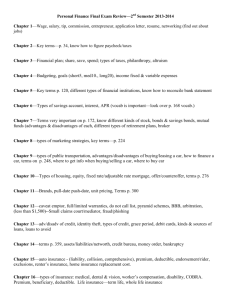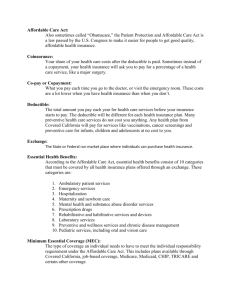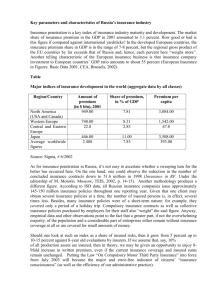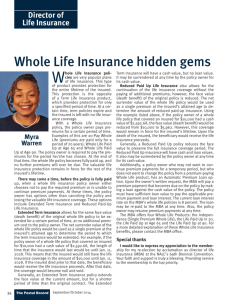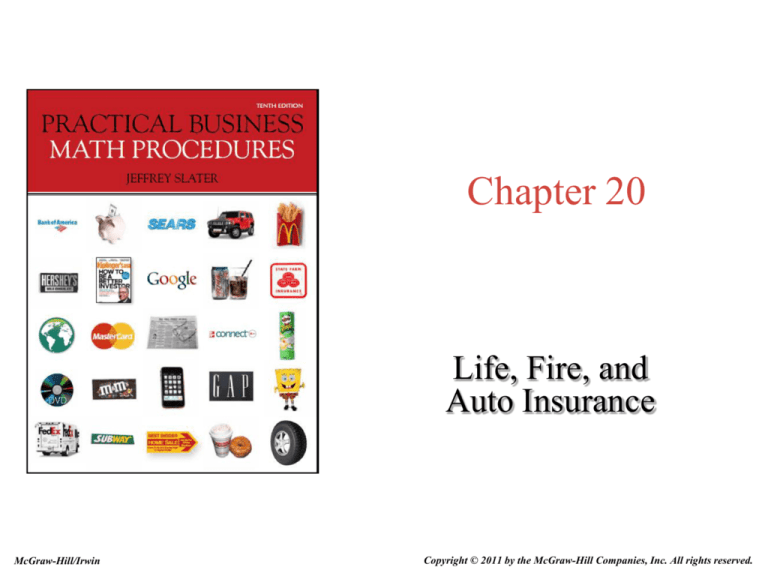
Chapter 20
Life, Fire, and
Auto Insurance
McGraw-Hill/Irwin
Copyright © 2011 by the McGraw-Hill Companies, Inc. All rights reserved.
#20
Life, Fire, and Auto Insurance
Learning Unit Objectives
LU20.1 Life Insurance
1. Explain the types of life insurance;
calculate life insurance premiums
2. Explain and calculate cash value and
other nonforfeiture options
20-2
#20
Life, Fire, and Auto Insurance
Learning Unit Objectives
LU20.2
Fire Insurance
1. Explain and calculate premiums for fire
insurance of buildings and their contents
2. Calculate refunds when the insured and the
insurance company cancel fire insurance
3. Explain and calculate insurance loss when
coinsurance is not met
20-3
#20
Life, Fire, and Auto Insurance
Learning Unit Objectives
LU20.3 Auto Insurance
1. Explain and calculate the cost of auto
insurance
20-4
Life Insurance
Insured - The policyholder
receiving coverage
Beneficiary - The person receiving
the insurance proceeds at the death
of the insured
20-5
Premium - Periodic
payments you make for
the cost of the insurance
(determined by actuaries)
Face amount - The amount
received (proceeds) upon the
death of the insured
Steps in Calculating Annual
Life Insurance Premiums
Step 2. Divide the amount of coverage by
$1,000 and multiply the answer by the
premium cost per $1,000
Step 1. Look up the age of the insured and the
type of insurance in Table 20-1 (for females
subtract 3 years). This gives the premium cost
per $1,000
20-6
Table 20.1 - Life Insurance Rates
Age
20
21
22
23
24
25
26
27
28
29
30
31
32
33
34
35
36
37
38
39
40
20-7
Five-year
term
1.85
1.85
1.85
1.85
1.85
1.85
1.85
1.86
1.86
1.87
1.87
1.87
1.88
1.95
2.08
2.23
2.44
2.67
2.95
3.24
3.52
Age
20
21
22
23
24
25
26
27
28
29
30
31
32
33
34
35
36
37
38
39
40
Straight
life
5.90
6.13
6.35
6.60
6.85
7.13
7.43
7.75
8.08
8.46
8.85
9.27
9.71
10.20
10.71
11.26
11.84
12.46
13.12
13.81
14.54
Age
20
21
22
23
24
25
26
27
28
29
30
31
32
33
34
35
36
37
38
39
40
Twentypayment life
8.28
8.61
8.91
9.23
9.56
9.91
10.29
10.70
11.12
11.58
12.05
12.57
13.10
13.67
14.28
14.92
15.60
16.30
17.04
17.81
18.61
Age
20
21
22
23
24
25
26
27
28
29
30
31
32
33
34
35
36
37
38
39
40
Twenty-year
endowment
13.85
14.35
14.92
15.54
16.05
17.55
17.66
18.33
19.12
20.00
20.90
21.88
22.89
23.98
25.13
26.35
27.64
28.97
30.38
31.84
33.36
Calculating Insurance Premiums
Bob Brady, age 40, wants to purchase a 5 year $200,000
insurance policy. Determine her annual premium
$200,000 (Coverage) = 200
1,000
20-8
Step 1
Term Insurance -- Pays face amount only if
you die within the period of the insurance.
The cheapest coverage. $200 x $3.52 = $704
Step 2
Straight Life (Ordinary Life) -- Provides permanent
protection. The insured pays the same premium each
year or until death. Has a built in cash savings feature.
$200 x $14.54 = $2,908
Step 2
Calculating Insurance Premiums
Twenty-Payment Life -- Similar to straight life
but insurer pays premiums for only the first 20
years. $200 x $18.61 = $3,722
Step 2
Twenty-Year Endowment -- Most expensive.
Combination of term and cash value. After 20
years your protection ends and you receive the
face value of the policy. $200 x $33.36 = $6,672
Step 2
Universal Life - A whole life insurance plan with
flexible premium schedules and death benefits.
Greater risk to the holder because premiums are
subject to interest rate fluctuations
20-9
Nonforfeiture Options - Figure 20.1
The value of an insurance policy that has built up cash value and provides an
opportunity for insurance coverage without additional premiums.
Option 1: Cash value (cash surrender value)
a. Receive cash value of policy.
b. Policy is terminated.
The longer the policy has been in effect the higher the cash value because
more premiums have been paid in.
Option 2: Reduced paid-up insurance
a. Cash value buys protection without paying new premiums.
b. Face amount of policy is related to cash value buildup and age of insured.
The face amount is less than original policy.
c. Policy continues for life (at a reduced face amount).
Option 3: Extended term insurance
a. Original face amount of policy continues for a certain period of time.
b. Length of policy depends on cash value built up and on insured’s age.
c. This option results automatically if policyholder doesn’t pay premiums and
fails to elect another option.
20-10
Table 20.2 - Nonforfeiture Options based on
$1,000 Face Value
Years
insurance
policy in
force
5
10
15
20
20-11
Cash
value
29
96
148
265
Straight life
Amount of
Extended
paid-up
term
Insurance Years
Day
86
9
91
259
18
76
371
20
165
550
21
300
Cash
value
71
186
317
475
20-payment life
Amount of
Extended
paid-up
term
insurance Years
Day
220
19
190
521
28
195
781
32
176
1,000
Life
Cash
value
92
319
619
1,000
20-year endowment
Amount of
Extended
paid-up
term
insurance Years
Day
229
23
140
520
30
160
790
35
300
1,000
Life
Nonforfeiture Options
Assume Bob Brady purchased a 20-payment life
policy and decided to stop the policy after it was in
force for 10 years. What would be his options?
1. Cash Value
$200,000 = 200 x $148 = $29,600
$1,000
2. Reduce paid-up insurance
3. Extended term insurance
Continue this $200,000 policy
for 20 years and 165 days
20-12
$200,000 = 200 x $371 = $74,200
$1,000
Fire Insurance
Table 20.3 - Fire insurance rates per $100 of coverage
Classification of building
Class A
Class B
Rating
of area
1
2
3
20-13
Building
.28
.33
.41
Contents
.35
.47
.50
Building Contents
.41
.54
.50
.60
.61
.65
Calculating Fire Insurance Premiums
Premium = Insured value x Rate
$100
Calculate the premium of a building with an
insured value of $190,000 and a Class B, Area
No. 2 rating. Insured contents are $80,000.
Premium = $190,000 = 1,900 x $.50 = $950
$100
Premium = $80,000 = 800 x $.60 = $480
$100
Total Premium = $950 + 480 = 1,430
20-14
Table 20.4 - Fire Insurance short-rate
and cancellation table
Time policy is
in force
Days
5
10
20
25
Months 1
2
3
4
20-15
Percent of annual rate
to be charged
8%
10
15
17
19
27
35
44
Time policy is
in force
Months
5
6
7
8
9
10
11
12
Percent of annual rate
to be charged
52%
61
67
74
81
87
96
100
Canceling Fire Insurance (Refunds)
Short-rate premium = Annual premium x Short rate
Refund = Annual premium - Short rate premium
Policyholder Cancels
Short rate Premium = $1430 x .67 = $958.10
Calculate the
refund if the
policy is
canceled after 7
months
Refund = $1430 - $958.10 = $471.90
Insurer Cancels
Months
Elapsed
Charge = $1,430 x 7 = $834.17
12
Refund = $1,430 - $834.17 = $595.83
20-16
Calculating What Insurance Company
Pays with Coinsurance Clause
The insured and the insurer share the risk. Encourages
property owners to purchase adequate coverage
Step 2. Multiply the fraction by the
amount of loss (up to the face value of
the policy)
Step 1. Set up a fraction. The numerator is the actual
amount of the insurance carried on the property. The
denominator is the amount of insurance you should be
carrying on the property to meet coinsurance (80%
times the replacement value)
20-17
Coinsurance
Suppose we carry $60,000 of fire insurance on
property that will cost $100,000 to replace. The
coinsurance clause is 80%. If we suffer a loss of
$20,000, how much will the insurance company pay?
Coverage
$60,000 x $20,000 = $15,000
$80,000
What you
should have
carried
$100,000 x .80
20-18
Loss
Auto Insurance
Liability Insurance (Compulsory Insurance) - Covers
any physical damages that you inflict on others or
their property. (Mandatory)
Bodily injury - injury
or death to people in
passenger car or
other cars, etc.
Property damage - injury
to other someone else’s
property, i.e. autos, trees,
buildings, hydrants, etc.
20-19
Auto Insurance
Comprehensive - covers
damages resulting from
theft, fire, falling objects, etc.
20-20
Collision - provides
protection against
damages to your car
caused by a moving
vehicle. Covers the cost
of repairs less the
deductible.
Problem
Calculate the annual auto premium for
Shirley who lives in Territory 5, is a
driver classified 17, and has a car with
age 3 and symbol 4. Her state has
compulsory insurance, and Shirley wants
to add the following options:
1. Bodily injury, 250/500
2. Property damage 5M
3. Collision, $200 deductible
20-21
4.
Comprehensive, $200
deductible
5.
Substitute transportation
6.
Towing & Labor
Table 20.5 - Compulsory insurance
Bodily injury to others
Class
10/20
Damage to someone else’s property
Class
5M*
10
17
18
20
10
17
18
20
$ 55
98
80
116
$129
160
160
186
Explanation of 10/20 and 5
10
20
Maximum paid to
one person per
accident for
bodily injury
Maximum paid for
total bodily
injury per
accident
*M means thousands.
20-22
5
Maximum paid for
property damage
per accident
Calculating Premium and Optional
Insurance Coverage
Table 20.6 Bodily injury
Class
10
17
18
20
15/30
27
37
33
41
20/40
37
52
46
59
20/50
40
58
50
65
25/50
44
63
55
72
25/60
47
69
60
78
50/100
69
104
89
119
100/300
94
146
124
168
250/500 500/1000
144
187
228
298
193
251
263
344
Table 20.7 Damage to someone else’s property
Class
10
17
18
20
20-23
10M
132
164
164
191
25M
134
166
166
193
50M
135
168
168
195
100M
136
169
169
197
Calculating Premium: Collision - Table 20.8
Classes
10-20
Age
group
1
2
3
4
5
Symbols 1-3
$300 ded.
180
160
148
136
124
Symbol 4
$300 ded.
180
160
148
136
124
Symbol 5
$300 ded.
187
166
154
142
130
Symbol 6
$300 ded.
194
172
166
160
154
Symbol 7
$300 ded.
214
190
183
176
169
Symbol 8
$300 ded.
264
233
221
208
196
Additional cost to reduce deductible
Class
10
17
18
20
20-24
From $300 to $200
13
20
16
26
From $300 to $100
27
43
33
55
Symbol 10
$300 ded.
279
246
233
221
208
Calculating Premium: Comprehensive –
Table 20.9
Classes
10-25
Age
group
1
2
3
4
5
Symbols 1-3
$300 ded.
61
55
52
49
47
Symbol 4
$300 ded.
61
55
52
49
47
Symbol 5
$300 ded.
65
58
55
52
49
Symbol 6
$300 ded.
85
75
73
70
67
Symbol 7
$300 ded.
123
108
104
99
94
Additional cost to reduce deductible: From $300 to $200 add $4
Table 20.10 Transportation and Towing
Substitute transportation
Towing and labor
20-25
$16
4
Symbol 8
$300 ded.
157
138
131
124
116
Symbol 10
$300 ded.
211
185
178
170
163
Problem
Calculate the annual auto premium
for Julie Fox who lives in
Territory 5, is a driver classified
17, and has a car with age 3 and
symbol 4. Her state has
compulsory insurance, and Julie
wants to add the following
options:
1. Bodily injury, 250/500
Compulsory
Bodily
Property
$ 98
$160
(Table 20.5)
(Table 20.5)
$228
$168
$191
(Table 20.6)
(Table 20.7)
(Table 20.8)
Options
Bodily
Property
Collision
($148 + $43)
2. Property damage 5M
3. Collision, $200 deductible
4.
Comprehensive $ 56
(Table 20.9)
($52 + 4)
Comprehensive, $200
deductible
Substitute trans.
16
5.
Substitute transportation
Towing & Labor
4
6.
Towing & Labor
Total annual premium - $921
20-26
Problem 20-14:
$1,547 x 0.35 = $541.45
$1,547 - $541.45 = $1,005.55 refund
20-27
Problem 20-17:
$300,000
$1,000 = 300 x $2.67 = $801
No cash value for term insurance.
20-28
Problem 20-21:
Class 18 operator
Compulsory, 10/20/5
Optional
Bodily injury, 500/1,000
Property damage, 50M
Collision, $200 deductible
$ 240 ($80 + $160)
251
168
280 ($264 + $16)
161 ($157 + $4)
Comprehensive,$200 deductible
Total Annual Premium
$1,100
20-29
Problem 20-22:
$100,000
$100 = 1,000 x $.66 = $660
Cost of premium = .96 x $660 = $633.60
Refund = .04 x $660 = $26.40
20-30
Problem 20-23:
$95,000
$100 = 950 x .59 = $560.50
8/12 = 2/3 x $560.50 = $373.67
20-31
Problem 20-26:
Insurance company pays
Property damage
$ 3,600
Collision ($900 - $300) 600
Bodily
10,000
7,000
$21,200
20-32
Rusty pays
$ 300 deductible
5,000 bodily
$5,300


